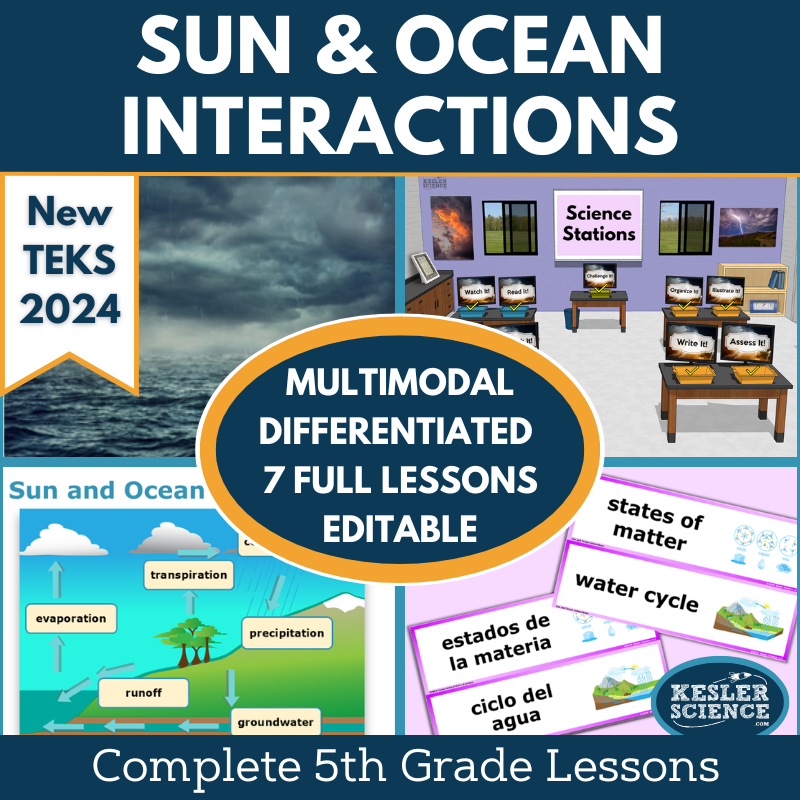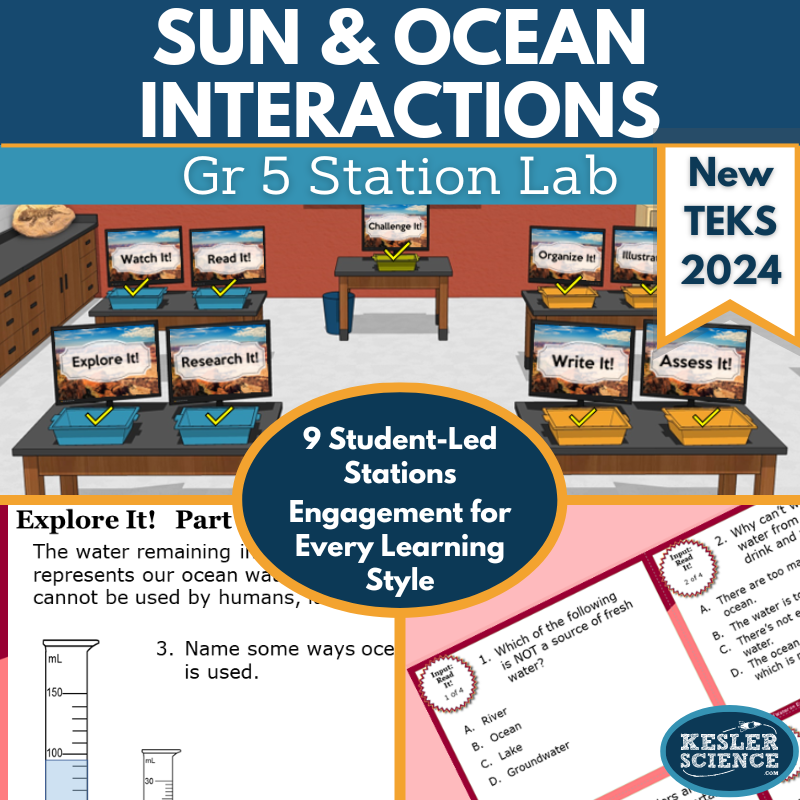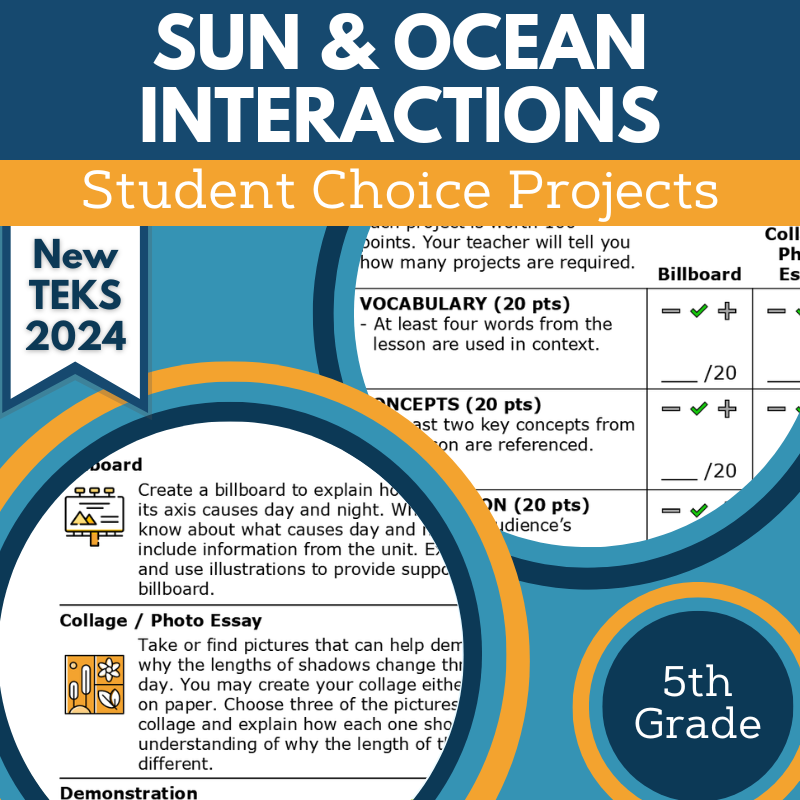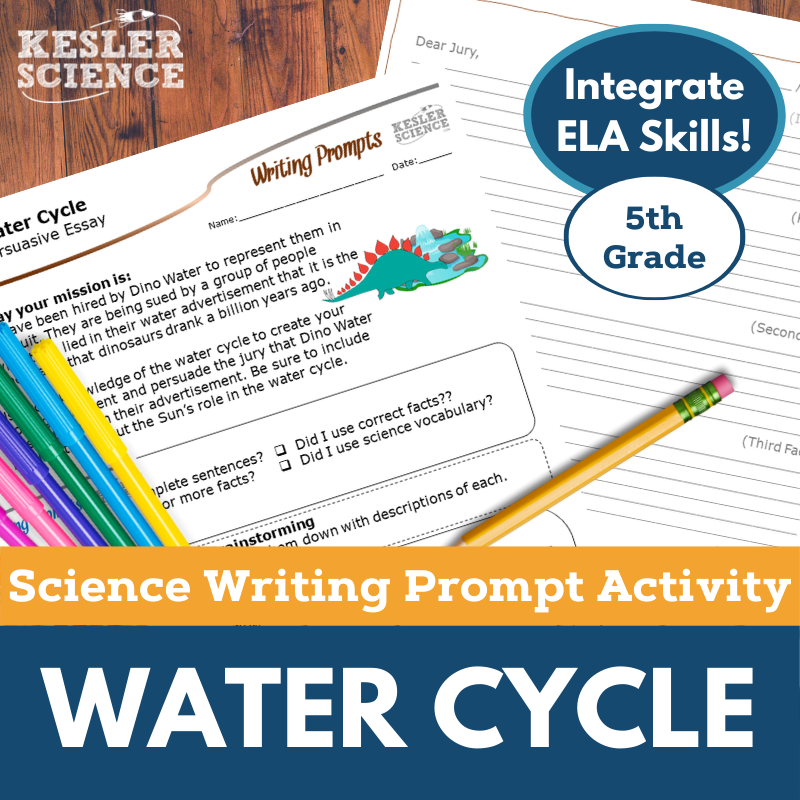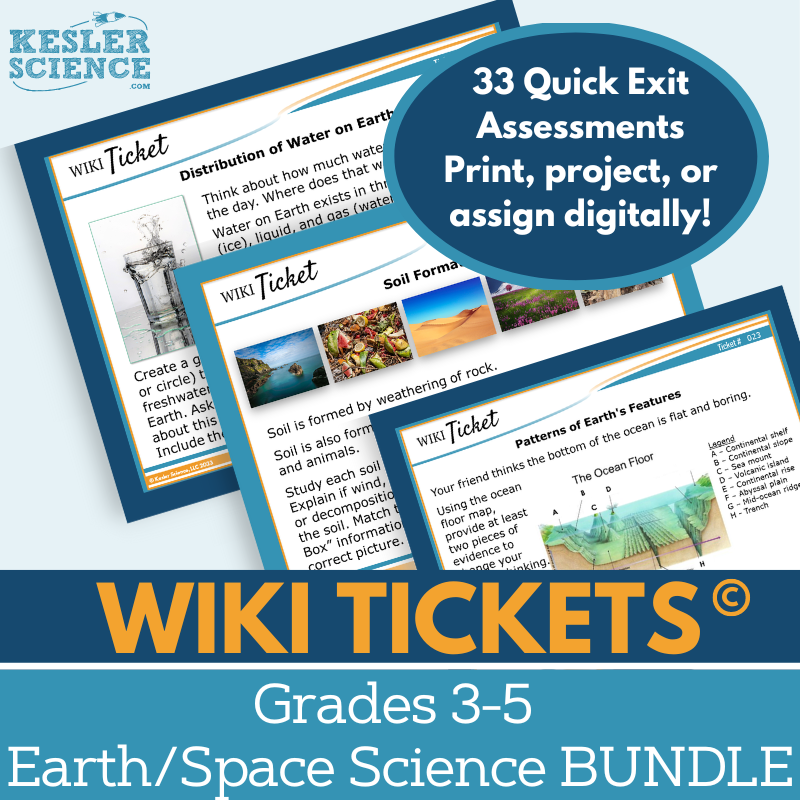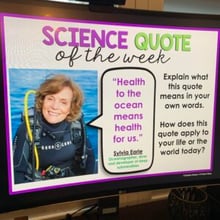Sun & Ocean Interactions Activities for 5th Grade Science
This 5th grade weather unit explores the Sun and ocean's roles in the water cycle and their impact on weather patterns, aligned with TEKS 5.10A. The resources below will give students a comprehensive understanding of the Sun and ocean interactions. All of the following materials are also included in the Kesler Science Membership.
This 5th grade weather unit explains how the Sun and ocean interact in the water cycle and impact weather patterns. The lesson includes editable PowerPoints, worksheets, choice projects, and assessments, with differentiated materials for all learners. It is aligned with the 2021 TEKS 5.10A standard and designed for flexible use in both in-person and virtual classrooms.
The unit follows the 5E Model with engaging activities for each phase. Students explore the Sun’s and ocean’s role in the water cycle through differentiated station labs, multimodal learning, and hands-on activities, such as reading, experiments, research, and video analysis. They demonstrate understanding by organizing, illustrating, and writing about the water cycle. Extension activities challenge early finishers.
The lesson includes interactive notebooks, note-taking templates, and editable PowerPoints in English and Spanish. Students apply their learning through student-choice projects and assessments updated for STAAR 2.0. This lesson requires little prep, supports differentiated learning, and offers flexibility for classroom or virtual use.
This 5th grade weather unit explains how the Sun and ocean interact in the water cycle and impact weather patterns. The lesson includes editable PowerPoints, worksheets, choice projects, and assessments, with differentiated materials for all learners. It is aligned with the 2021 TEKS 5.10A standard and designed for flexible use in both in-person and virtual classrooms.
The unit follows the 5E Model with engaging activities for each phase. Students explore the Sun’s and ocean’s role in the water cycle through differentiated station labs, multimodal learning, and hands-on activities, such as reading, experiments, research, and video analysis. They demonstrate understanding by organizing, illustrating, and writing about the water cycle. Extension activities challenge early finishers.
The lesson includes interactive notebooks, note-taking templates, and editable PowerPoints in English and Spanish. Students apply their learning through student-choice projects and assessments updated for STAAR 2.0. This lesson requires little prep, supports differentiated learning, and offers flexibility for classroom or virtual use.
This student-led station lab focuses on the interactions between the Sun and the ocean, driving the water cycle and influencing weather, aligned with the TEKS 5.10A standard. Designed for 5th-grade students, the activities engage them in exploring Earth science concepts with minimal teacher direction. The station lab includes nine modular activities that allow students to direct their own learning while facilitating teacher support.
The stations provide a variety of resources to help students understand the water cycle and weather processes. Input stations include Explore It! where students apply their knowledge through activities, Watch It! with videos and questions, Read It! featuring short reading passages in English and Spanish, and Research It! which allows students to explore facts and graphs about the Sun's energy and its impact on the oceans.
Output stations give students opportunities to demonstrate their understanding. In Organize It! students use manipulatives or digital tools, Illustrate It! asks them to draw a water cycle model, and Write It! has them respond to prompts with complete sentences. Assess It! helps students assess their grasp of the Sun’s role in the water cycle through task cards, while a bonus station, Challenge It!, provides extension activities for advanced learners.
This resource can be used in both in-person and virtual classrooms, offering flexible, differentiated learning options for all students.
This student-led station lab focuses on the interactions between the Sun and the ocean, driving the water cycle and influencing weather, aligned with the TEKS 5.10A standard. Designed for 5th-grade students, the activities engage them in exploring Earth science concepts with minimal teacher direction. The station lab includes nine modular activities that allow students to direct their own learning while facilitating teacher support.
The stations provide a variety of resources to help students understand the water cycle and weather processes. Input stations include Explore It! where students apply their knowledge through activities, Watch It! with videos and questions, Read It! featuring short reading passages in English and Spanish, and Research It! which allows students to explore facts and graphs about the Sun's energy and its impact on the oceans.
Output stations give students opportunities to demonstrate their understanding. In Organize It! students use manipulatives or digital tools, Illustrate It! asks them to draw a water cycle model, and Write It! has them respond to prompts with complete sentences. Assess It! helps students assess their grasp of the Sun’s role in the water cycle through task cards, while a bonus station, Challenge It!, provides extension activities for advanced learners.
This resource can be used in both in-person and virtual classrooms, offering flexible, differentiated learning options for all students.
These Water Cycle Student Choice Projects align with the 2021 TEKS Earth and Space Science standard 5.10A, offering 5th graders the chance to choose a project that fits their preferred output style. The project page outlines six student-led options and a “design your own” project. A grading rubric allows for assessments by teachers, peers, or students themselves. This resource is also part of the Sun & Ocean Interactions Complete Lesson for TEKS 5.10A.
The projects are flexible, with teachers able to modify the rubric as needed. Students can use various creative, multimodal methods to demonstrate their understanding.
The resource includes nine project options, a “design your own” project, teacher directions, and editable rubric pages that assess vocabulary, concepts, presentation, clarity, and accuracy. The projects require standard classroom supplies like paper, markers, and scissors, with many options available for digital completion. Differentiated versions of the project page support students needing remediation, while challenge options are available for advanced learners.
The Water Cycle Student Choice Projects align with the 2021 TEKS Earth and Space Science standard 5.10A, offering 5th graders the chance to choose a project that fits their preferred output style. The project page outlines six student-led options and a “design your own” project. A grading rubric allows for assessments by teachers, peers, or students themselves. This resource is also part of the Sun & Ocean Interactions Complete Lesson for TEKS 5.10A.
The projects are flexible, with teachers able to modify the rubric as needed. Students can use various creative, multimodal methods to demonstrate their understanding.
The resource includes nine project options, a “design your own” project, teacher directions, and editable rubric pages that assess vocabulary, concepts, presentation, clarity, and accuracy. The projects require standard classroom supplies like paper, markers, and scissors, with many options available for digital completion. Differentiated versions of the project page support students needing remediation, while challenge options are available for advanced learners.
The Water Cycle Science and ELA Integrated Writing Activity helps 5th grade students test their understanding of the water cycle through a persuasive essay. This TEKS aligned activity encourages students to explore the interaction between the Sun and the ocean in the water cycle while strengthening their writing skills. Designed for both in-person and virtual learning, the activity engages students even outside of the classroom.
The resource includes teacher directions, rubrics, projection versions for virtual classrooms, and printable full-sized and half-sheet handouts. Additionally, a digital interactive PowerPoint version, which can be converted to Google Slides, allows for remote completion. The writing prompt can be used for various purposes, such as a pre-test, student project, early finishers’ elaboration, or differentiation exercise, and is ideal for extra credit or make-up work. This activity works well in cross-curricular settings and can be displayed or compiled in student anthologies.
The Water Cycle Science and ELA Integrated Writing Activity helps 5th grade students test their understanding of the water cycle through a persuasive essay. This TEKS aligned activity encourages students to explore the interaction between the Sun and the ocean in the water cycle while strengthening their writing skills. Designed for both in-person and virtual learning, the activity engages students even outside of the classroom.
The resource includes teacher directions, rubrics, projection versions for virtual classrooms, and printable full-sized and half-sheet handouts. Additionally, a digital interactive PowerPoint version, which can be converted to Google Slides, allows for remote completion. The writing prompt can be used for various purposes, such as a pre-test, student project, early finishers’ elaboration, or differentiation exercise, and is ideal for extra credit or make-up work. This activity works well in cross-curricular settings and can be displayed or compiled in student anthologies.
WIKI Tickets formative assessments for 3rd-5th grade science provide a fun and engaging way to check student understanding. The Earth/Space Science Set includes 33 assessments, each with five formats: a full-screen projection version, three handout versions (full, split, and quarter-page sizes), and an interactive version for digital assignment through PowerPoint or Google Slides.
Aligned with NGSS and TEKS standards, these assessments cover key topics such as weather patterns, Earth’s surface changes, the water cycle, renewable and nonrenewable resources, and more. Some topics include multiple tickets, with a bonus table of contents file to show alignment.
These assessments can be used in both in-person and virtual learning environments, with options for projection, printouts, or digital use. They can serve as exit tickets, bellringers, or quick checks for understanding.
WIKI Tickets formative assessments for 3rd-5th grade science provide a fun and engaging way to check student understanding. The Earth/Space Science Set includes 33 assessments, each with five formats: a full-screen projection version, three handout versions (full, split, and quarter-page sizes), and an interactive version for digital assignment through PowerPoint or Google Slides.
Aligned with NGSS and TEKS standards, these assessments cover key topics such as weather patterns, Earth’s surface changes, the water cycle, renewable and nonrenewable resources, and more. Some topics include multiple tickets, with a bonus table of contents file to show alignment.
These assessments can be used in both in-person and virtual learning environments, with options for projection, printouts, or digital use. They can serve as exit tickets, bellringers, or quick checks for understanding.
Year-Round Resources
These year-round activities will increase your students' understanding of many middle school science topics. All of these activities are also included in the Kesler Science Membership.
Visual Data & Graphing
You're not alone if your students struggle with understanding graphs, charts, and tables. It's a skill that takes an enormous amount of practice. This resource will help students build a strong foundation in analyzing data and creating their own data visualizations.
Bell Ringers and Warm-Ups
These middle school science bell ringers are an excellent way to engage your students as soon as they walk into your classroom. This comprehensive FULL YEAR resource includes everything you need to start off each science class with an interesting warm-up activity.
Review Board Games
Each game board has been carefully designed to keep students engaged. There are 10 different action spaces on each board and dozens of question cards. All of the actions are related to science concepts and keep the students motivated throughout the game.
Each game is ready to play. Simply print out the board and the cards and let the students enjoy reviewing nine different units.
Essential Questions and Standards
Below are the essential questions and standards associated with the lessons and activities included in the atoms unit. This topic is only one of more than 100 middle school science topics included in the Kesler Science Membership.
-
How do the Sun and the ocean work together in the water cycle?
-
How does the water cycle affect weather?
-
TEKS Science - 5.10A Sun & Ocean Interactions
Kesler Science Membership
Imagine never having to search for another middle school science lesson again. The membership gives you access to ALL of the Kesler Science products in one place (Yes, including everything above).
Say goodbye to long hours of lesson prep.

